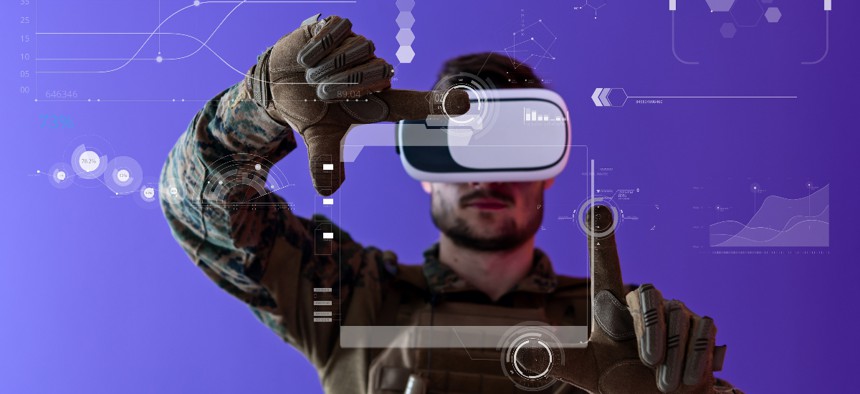Artificial Intelligence and Drone Tactics Maneuver into Advanced Military Simulations

.shock/Getty Images
The war in Ukraine has made drones a powerful frontline weapon, more user-friendly AIs have been created, and the quality of computer graphics has also improved.
It’s been a couple years since Nextgov last talked with company officials from Bohemia Interactive Simulations—BISim—the group that makes realistic simulation and virtual reality training applications for militaries around the world. At the time of the last interview, the pandemic had just struck, the vaccine was not yet available, and BISim was being tasked with helping to provide realistic training for soldiers at a time when getting together in person wasn’t safe.
The company had also just launched its Virtual Battle Space 4 product, which allows militaries to set up virtual training with realistic conditions anywhere in the world, using the actual terrain, weather conditions and other factors that they would really experience in any theater of operations.
Since then, a lot has changed in the world. For example, the last time we talked, militaries were just starting to experiment with drones for uses beyond reconnaissance. Now, the war in Ukraine has made drones a powerful frontline weapon, with everything from modified commercial vehicles to flying suicide bombs being employed in multiple roles. Powerful and more user-friendly AIs have been created, and the quality of computer graphics has also improved. All of that likely requires upgrades to the VBS4 simulation’s tactics and capabilities, so we thought it would be a good time to check back in with them.
Nextgov sat down with Bohemia Interactive Simulations Chief Product Officer Pete Morrison to chat about evolving and asymmetrical military tactics, tapping into better realism through graphics and artificial intelligences, and other factors affecting one of the most realistic military training simulations in the world today.
Nextgov: Thanks for joining us. Before we start, can you refresh us on what you do, and how things in general have changed since the last time we spoke back in 2021?
Morrison: Of course. When we last spoke, we’d only just released VBS4, which is a user-friendly, whole-earth visual and constructive simulation that also functions as a simulation host. The military uses this software to conduct combined land, air and sea collective training, rehearse missions and experiment with various battle and defense tactics and strategies. Two years later we continue to add new capabilities and push the bounds of the possible to exploit computer game technologies for military training.
VBS4 has rapidly evolved with user feedback and funding. For example, VBS4 is now part of the US Army [Training Simulation Software/Training Management Tools] effort, and we’ve made the in-game experience even easier for the trainees, so they can focus on learning without technology getting in the way. This includes improving our support for gamepads—most soldiers prefer a gamepad to keyboard and mouse—and streamlining in-game interactions. Most recently we have overhauled our sensor simulation using physics-based algorithms, and I believe we are now providing the most photo-realistic sensor representation on the market, thanks to game rendering and shading techniques.
However, any rendering engine is only as good as the data it renders, and this is why we invested heavily in a new terrain platform called Mantle ETM (Enterprise Terrain Management). Through our work with the U.S. Army and others, we realized the need to provide a high fidelity digital twin of planet Earth for ingestion into VBS and other connected simulations. Mantle ETM also features heavily in TSS/TMT and a number of premier military organizations are also rolling out Mantle ETM to replace their legacy terrain generation processes. We are also working with industry leaders like Blackshark.ai to deliver the highest possible 3D terrain for simulation, to ensure a realistic environment to support training and mission rehearsal.
Nextgov: And this simulation is being used by militaries around the world?
Morrison: Yes, hundreds of thousands of military personnel use BISim’s VBS software products for training, including over 60 NATO and NATO-friendly countries and more than 300 integrators and prime contractors. Many have made significant funding commitments to extend VBS product capabilities beyond what is provided in the baseline, including new AI behaviors and new platforms like UAV capabilities based upon observations of the war in Ukraine.
Our customers include the U.S. Army, U.S. Marine Corps, Canadian Armed Forces, French Army, Bundeswehr, Swedish Armed Forces, Australian Defense Force and the New Zealand Defense Force.
We serve and support a diverse range of military training and simulation use cases, including close air support procedures, driver and gunnery training and mission rehearsals.
Nextgov: Can you give us some specific examples of militaries that are using your simulation?
Morrison: Of course. The U.S. Army deployed BISim’s VBS3 software to its Games For Training program, delivering advanced simulation technology to meet the Army’s complex training needs, facilitate ease-of-use and provide rapid, cost-efficient scenario generation. And VBS4, VBS Blue IG and Mantle ETM are all used within the U.S. Army TSS/TMT program.
The U.S. Marine Corps is using VBS4 on its Wargaming program and is testing both VBS4 and VBS Blue IG for wider deployment.
The Australian Defense Force deployed BISim’s Protected Route Clearance Capability as part of the ADF’s Project Ningaui, leveraging an immersive collective trainer to enable individual crew positions within a capability brick to interact and master techniques, tactics and procedures.
The UK Ministry of Defense selected BISim’s VBS4 and VBS Blue IG as its DVS2 solution to drive simulated activity—including operations planning and rehearsal, decision support, and research and development—across all levels of training.
Nextgov: Thank you for that detailed overview. You mention drones, and when we last talked some militaries were experimenting with using them in more complex roles. Now with the war in Ukraine, they are both frontline units and deep penetration tools. It’s something that any military can expect to encounter in future conflicts. How has that been added to the simulation?
Morrison: The drone warfare employed in Ukraine has influenced the doctrine of military forces worldwide, and drones will be a standard part of warfare in the future. We have been adding new unmanned aerial systems capabilities to VBS based upon the videos we see coming out of Ukraine—in the public domain—from dropping grenades through to kamikaze drones.
We’ve also added anti-drone weapons and built a range of example scenarios and videos. VBS is the perfect platform to experiment with, and train for, drone offense and defense. The capabilities are now being fine-tuned with customer feedback.
Nextgov: As you add drones to VBS4, are you able to see how they can change the battlefield and give advantages to one side or the other?
Morrison: Tactical drones that can be launched on or just behind the frontline represent a step-change in military tactics that will be as significant as the advent of the modern battle tank, the attack helicopter or even maneuver warfare. Tactical drones are being used in Ukraine for situational awareness, offensive strikes—like dropping bombs—and for directing artillery fire.
They represent a powerful force multiplier and are a key reason why Ukrainian forces have been able to hold their own against the Russian aggressors. We have moved quickly to ensure that VBS is able to support training and experimentation in drone warfare, and we see this as a major focus going forward.
Nextgov: So, do you anticipate that militaries will be able to use the simulation to refine their own drone and anti-drone tactics without first having to face them in combat?
Morrison: Yes. VBS was already heavily used to simulate high altitude drones, like providing a camera feed from a simulated Global Hawk, and also for engaging with weapons systems like Hellfires. And we already had tactical anti-drone weapons in the training game. VBS is often used by militaries to refine their tactics, techniques and procedures and we have no doubt that VBS will be used for TTPs related to tactical drone warfare. We also allow our customers to import their own 3D models, like those that represent new types of drones, and customize the in-game performance of those assets.
Nextgov: Another big advancement in recent years is the rise of more powerful artificial intelligences. Has BISim upgraded its AI so that the simulated adversaries, and also the possible allied units, behave even more realistically now?
Morrison: Yes, tactical AI has been a major focus of our investment over the last few years and we continue to build additional complex behaviors for our customers to leverage. One of the key differences between VBS4 and VBS3 is that VBS4 can support massive entity counts. And for the first time a subset of our customers are also using it for constructive simulations where an AI is put against another AI, as opposed to virtual simulations with humans versus humans or humans versus an AI.
VBS4 provides a high fidelity 3D environment at the ground level, and our AI will use cover and move tactically, like bounding, where appropriate. We will be demonstrating our latest behaviors at ITEC in April, and we will release a large set of new behaviors with VBS4 23.2 towards the end of 2023. Our goal is to provide repeatable, believable AI that can replace human role-players in tactical training scenarios. Our AI navigates complex urban areas, moves tactically and is capable of performing complex actions that change depending on the threat.
Nextgov: A final area that has really been boosted for both videogames and simulations is the rise in realistic, true-to-life graphics like what we have seen with the release of the Unreal Engine 5. How critical is it for military simulations to have realistic graphics, and is that a priority for VBS4 and your other simulations?
Morrison: Yes. We have heavily invested in graphical fidelity and we were recently complemented on the graphical quality of VBS4/VBS Blue IG at a recent U.S. Army event.
“Good graphics” relies on both state-of-the-art rendering technology and high fidelity 3D content, and VBS delivers both. Like Unreal, we use all the capabilities of modern graphic cards to deliver photo-realistic scenes at high frame rates. We have a team of more than 20 talented developers working to ensure that our engine—VBS Blue—maintains pace with the best of breed game engines, while still supporting demanding military use cases.
For example, a typical computer game doesn’t need high fidelity sensor simulation, ultra-long range zoom or the ability to render tens of thousands of entities on screen at once. However, these are the types of features that our customers expect, in addition to great graphics.
John Breeden II is an award-winning journalist and reviewer with over 20 years of experience covering technology. He is the CEO of the Tech Writers Bureau, a group that creates technological thought leadership content for organizations of all sizes. Twitter: @LabGuys




